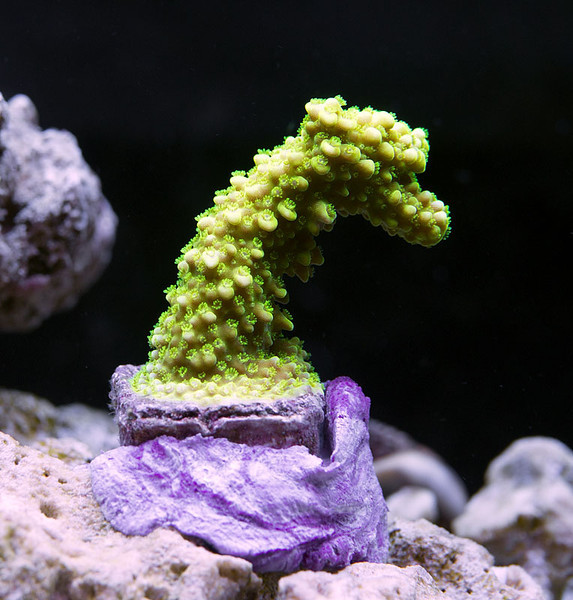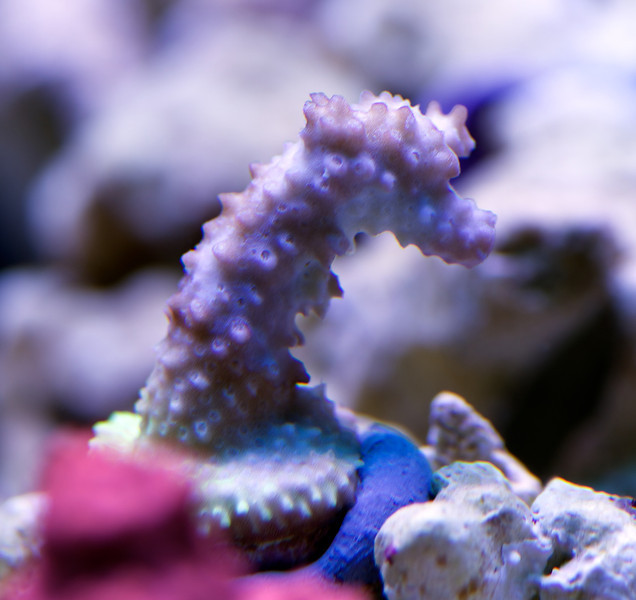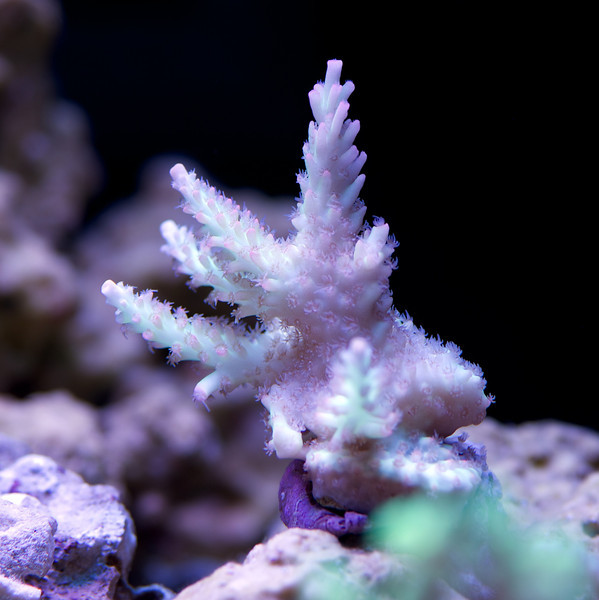Patrick Cox
Active member
Hi,
First let me apologize for the long post...
I started a 75G SPS system back in January. I cured my rock from Oct-Jan to remove phosphates / develop bio filter, then I started my tank in January, started adding SPS in late Feb/early March, added dosing pumps in April, and now here I am.
My setup is...
75G display
20G sump
90-160G rated Reef Octopus Skimmer
I run GAC/GFO (more on GFO in a minute)
Filter sock
ATI 6x39 Watt Dimmable fixture - 7" above water surface
photoperiod:
4 bulbs - 10-noon (25%-100% evenly over period)
6 bulbs Noon-6PM - 100%
4 bulbs - 6PM - 8PM - (100%-25% evenly over period)
Par at 100% for SPS ranges from 250 - 415
Alk/Ca Dosing pumps
Apex Controller
Parameters
SG - 1.026 - very consistent
Temp - 77.5-78.5 - controlled by Apex
PH - 8.15 - 8.35 (morning - end of day) (calibrated probe)
Alk - 8.3-8.6 (Salifert)
Ca - 440
Mg - 1320
NO3 - 0.2 (Salifert)
PO4 - 0.0 (Hanna Checker)
Maintenance:
Change filter sock twice per week
5G water change each week
Livestock:
Various Acros, Montis & a few LPS
6 small fish
Feeding:
-I feed the fish 2 times per day. Mainly pellets and flakes but I do feed frozen some.
-Back in April, I started feeding Oyster feast 2-3 times per week because my colors were not great and I thought my nutrients were too low.
-I also started Pohls Xtra in early May but that didn't seem to do anything so I stopped a couple weeks ago. (Not sure if stopping may have something to do with recent coral losses.)
So as I mentioned, I have not been happy with the colors of some of my corals and I have tried a number of different things with really no success. Some of my corals seem happy, and some don't look that great. Recently I lost a "Pearlberry" - it lasted about 2 months and then turned white and died pretty quickly. Now I have a Bali Green Slimer that I added in early April that is not doing well. It was losing color and turning brown and the guy at the shop where I purchased it told me to lower it in the tank to get less light and now it is looking worse. The brown is turning to white in spots. Not sure I got very good advice on that. I don't think this one will make it.
From what I have read, there are likely two possible culprits - Nutrients and Light....
Nutrients:
Amazingly, I turned my GFO reactor off one month ago and my PO4 is still 0.0. Not sure how that is happening because I feed regularly. I am still running GAC so maybe I should turn that off as well?
Lights:
I know I have a good fixture and it is capable of sustaining SPS but I am wondering if I have an issue with placement of certain corals in the tank. I have a Par meter and the par in my tank ranges from 250-415. Most of the Acros are in the 350-400 range at full power. I think this is adequate to grow and color up acros but maybe I have issues with placement of specific corals?
Lastly maybe my tank is still too young for some SPS?
Sorry for the long post but I want to stay on the right path with my tank so any advice you can provide on improving my journey would be appreciated...
Here is a before and after of my Bali Green Slimer:
Slimer As new:

Slimer today:

Here is a coral that seems to be doing well...
Strawberry Shortcake as new:

Strawberry Shortcake Today:

Current FTS:

First let me apologize for the long post...
I started a 75G SPS system back in January. I cured my rock from Oct-Jan to remove phosphates / develop bio filter, then I started my tank in January, started adding SPS in late Feb/early March, added dosing pumps in April, and now here I am.
My setup is...
75G display
20G sump
90-160G rated Reef Octopus Skimmer
I run GAC/GFO (more on GFO in a minute)
Filter sock
ATI 6x39 Watt Dimmable fixture - 7" above water surface
photoperiod:
4 bulbs - 10-noon (25%-100% evenly over period)
6 bulbs Noon-6PM - 100%
4 bulbs - 6PM - 8PM - (100%-25% evenly over period)
Par at 100% for SPS ranges from 250 - 415
Alk/Ca Dosing pumps
Apex Controller
Parameters
SG - 1.026 - very consistent
Temp - 77.5-78.5 - controlled by Apex
PH - 8.15 - 8.35 (morning - end of day) (calibrated probe)
Alk - 8.3-8.6 (Salifert)
Ca - 440
Mg - 1320
NO3 - 0.2 (Salifert)
PO4 - 0.0 (Hanna Checker)
Maintenance:
Change filter sock twice per week
5G water change each week
Livestock:
Various Acros, Montis & a few LPS
6 small fish
Feeding:
-I feed the fish 2 times per day. Mainly pellets and flakes but I do feed frozen some.
-Back in April, I started feeding Oyster feast 2-3 times per week because my colors were not great and I thought my nutrients were too low.
-I also started Pohls Xtra in early May but that didn't seem to do anything so I stopped a couple weeks ago. (Not sure if stopping may have something to do with recent coral losses.)
So as I mentioned, I have not been happy with the colors of some of my corals and I have tried a number of different things with really no success. Some of my corals seem happy, and some don't look that great. Recently I lost a "Pearlberry" - it lasted about 2 months and then turned white and died pretty quickly. Now I have a Bali Green Slimer that I added in early April that is not doing well. It was losing color and turning brown and the guy at the shop where I purchased it told me to lower it in the tank to get less light and now it is looking worse. The brown is turning to white in spots. Not sure I got very good advice on that. I don't think this one will make it.
From what I have read, there are likely two possible culprits - Nutrients and Light....
Nutrients:
Amazingly, I turned my GFO reactor off one month ago and my PO4 is still 0.0. Not sure how that is happening because I feed regularly. I am still running GAC so maybe I should turn that off as well?
Lights:
I know I have a good fixture and it is capable of sustaining SPS but I am wondering if I have an issue with placement of certain corals in the tank. I have a Par meter and the par in my tank ranges from 250-415. Most of the Acros are in the 350-400 range at full power. I think this is adequate to grow and color up acros but maybe I have issues with placement of specific corals?
Lastly maybe my tank is still too young for some SPS?
Sorry for the long post but I want to stay on the right path with my tank so any advice you can provide on improving my journey would be appreciated...
Here is a before and after of my Bali Green Slimer:
Slimer As new:

Slimer today:

Here is a coral that seems to be doing well...
Strawberry Shortcake as new:

Strawberry Shortcake Today:

Current FTS:


